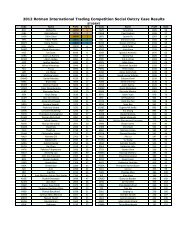RITC 2012 Case Package - Rotman International Trading ...
RITC 2012 Case Package - Rotman International Trading ...
RITC 2012 Case Package - Rotman International Trading ...
Create successful ePaper yourself
Turn your PDF publications into a flip-book with our unique Google optimized e-Paper software.
Assets Description<br />
Assets<br />
Capacity Transport or<br />
Conversion Period<br />
Cost<br />
CL-STORAGE Storage for Crude Oil Spot<br />
in Cushing<br />
10K Barrels N/A $500/day<br />
AK-STORAGE Storage for Crude Oil in<br />
Alaska<br />
10K Barrels N/A $500/day<br />
NYC-STORAGE Storage for Crude Oil in<br />
New York City<br />
10K Barrels N/A $500/day<br />
AK-CS-PIPE Pipeline from Alaska to<br />
Cushing<br />
10K Barrels 1 Day (30 seconds) $40,000/use<br />
CS-NYC-PIPE Pipeline from Cushing to 10K Barrels 1 Day (30 seconds) $20,000/use<br />
CL-REFINERY<br />
New York City<br />
Crude Oil Refinery (3:2:1) 30K Barrels 1.5 Days (45<br />
seconds)<br />
<strong>Rotman</strong> <strong>International</strong> <strong>Trading</strong> Competition <strong>2012</strong><br />
© Financial Research and <strong>Trading</strong> Lab, <strong>Rotman</strong> School of Management, U of T<br />
$300,000 per<br />
2 days<br />
*Note: There are no storage requirements for the physical products: RBOB Gasoline and Heating Oil. Automatic storage at no cost<br />
can be assumed for these products.<br />
Traders will need to focus on four main models that interact with the physical (spot) market for crude oil: the<br />
fundamental model, the storage model, the transport model and the refinery model. In the fundamental<br />
model, traders will receive news releases affecting the supply of crude oil, which can be used to forecast<br />
commodity prices. These releases will be amongst updates on geopolitical news and general economic<br />
indicators further affecting the energy market in North America. Traders will respond to the various news<br />
releases by buying and selling futures contracts. In the storage, transport, and refinery models, traders will<br />
balance the costs of operation with expected returns to earn arbitrage profits. For example, based on the<br />
refinery’s fixed cost to operate, traders can calculate when it’s profitable to purchase crude oil, convert it into<br />
products, and sell the products. Similarly, traders can calculate when it’s profitable to purchase crude in<br />
Alaska, transport it to Cushing, and sell crude oil spot.<br />
Fundamental Model<br />
The fundamental model will test the ability of traders to correctly interpret news releases and predict the<br />
price impact on crude oil. The fundamental value of crude oil is based on two distinct factor shocks: news<br />
effects and the weekly EIA reports. In this case, all news releases are independent of one another.<br />
There are 8 weekly EIA reports that will be released. Each report will contain an expected storage build/draw,<br />
and the actual storage build/draw. The fundamental value of CL will adjust at a ratio of $1 for every 10 million<br />
barrel differential. For example, if analysts expected a 6 million barrel build, and the actual EIA value was a 16<br />
million barrel draw, the price of CL would increase by $2.20. (expected +6, actual -16, difference +22).<br />
19<br />
BP Canada Commodities <strong>Case</strong>



